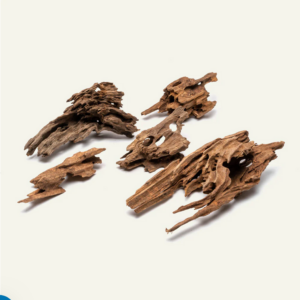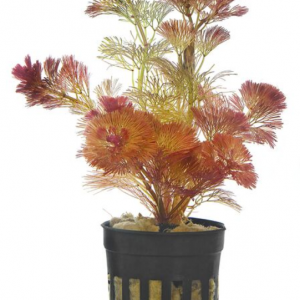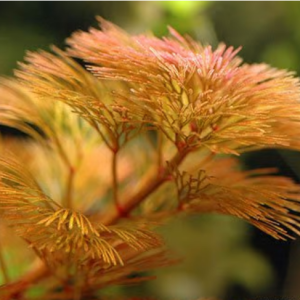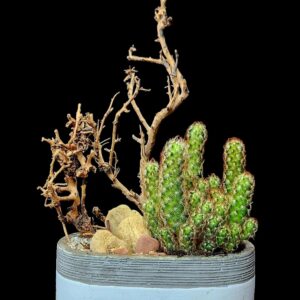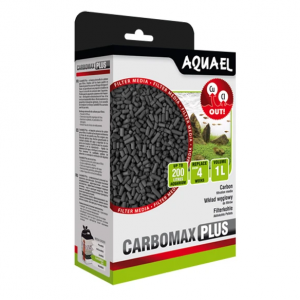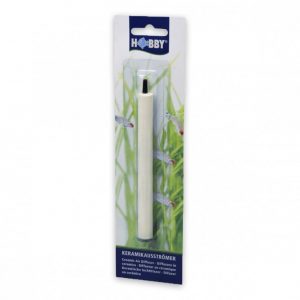Shop
Showing 409–432 of 1711 results
-
Live Plants & Neutrients, Plants, Tissue Culture Cup
Bucephalandra pygmaea
Bucephalandra pygmaea Care Guide
Description
Bucephalandra pygmaea is a small, slow-growing aquatic plant belonging to the Araceae family, native to Borneo. It is highly valued in aquascaping for its compact size, unique leaf shapes, and striking colors—ranging from deep green to blueish or even slightly metallic under optimal conditions. The leaves are typically small (1–3 cm), thick, and slightly wavy, growing in a rosette pattern. Unlike larger Bucephalandra species, B. pygmaea remains tiny, making it ideal for nano tanks, foreground placement, or attaching to rocks and driftwood.Care Requirements
1. Lighting:
– Low to moderate light is sufficient; high light may encourage algae growth on its slow-growing leaves.
– Intense lighting can enhance colors but is not necessary for survival.2. CO2 & Nutrients:
– CO2 supplementation is not required but can promote faster growth and better coloration.
– Benefits from a nutrient-rich environment (liquid fertilizers or root tabs if planted in substrate).3. Water Parameters:
– Temperature: 22–28°C (72–82°F)
– pH:** 5.5–7.5 (prefers slightly acidic to neutral water)
– Hardness: Soft to moderately hard (2–15 dGH)
– Good water flow helps prevent algae buildup.4. Placement & Substrate:
– Best attached to hardscape (rocks, driftwood) using super glue gel or thread.
– Can also be planted in substrate, but rhizome must not be buried (to avoid rot).5. Maintenance:
– Slow grower; requires minimal trimming.
– Prune old or melting leaves to encourage new growth.
– Sensitive to sudden water parameter changes—acclimate slowly when introducing to a new tank.Challenges
– Melting: May shed leaves when first introduced but usually recovers if kept stable.
– Algae:Slow growth makes it prone to algae; maintain good tank hygiene and avoid excessive light.
– Rhizome rot: Ensure the rhizome is not buried or smothered.With patience and stable conditions, Bucephalandra pygmae thrives as a beautiful, low-maintenance addition to any aquascape! 🌿💙
SKU: n/a -
Live Plants & Neutrients, Plants, Tissue Culture Cup
Bucephalandra White Sp Limited
Bucephalandra ‘White’ Care Guide
Description
Bucephalandra ‘White’ is a rare and highly sought-after variant of Bucephalandra, prized for its stunning pale or whitish leaves that contrast beautifully with typical dark-green or blue Buce species. The leaves are thick, slightly wavy, and often exhibit a marbled or speckled appearance, with hints of green or silver. Like other Bucephalandra, it grows slowly, forming compact clumps with a creeping rhizome.This variety is typically smaller, making it ideal for nano tanks, foreground placement, or attaching to hardscape (rocks, driftwood). Under optimal conditions, it may produce small, white or cream-colored flowers when grown emersed.
Care Requirements
1. Lighting
– Low to moderate light is best; too much light can promote algae on its slow-growing leaves.
– Intense lighting may enhance its unique coloration but isn’t necessary for survival.2. CO2 & Fertilization
– CO2: Not required but can encourage faster growth and better color development.
– Nutrients: Benefits from a nutrient-rich environment—use liquid fertilizers (especially potassium and iron) or root tabs if planted in substrate.3. Water Parameters
– Temperature: 22–28°C (72–82°F)
– pH: 5.5–7.5 (prefers slightly acidic to neutral water)
– Hardness: Soft to moderately hard (2–15 dGH)
– Water Flow: Moderate flow helps prevent debris buildup on leaves.4. Placement & Attachment
– Best attached to rocks or driftwood (use super glue gel or thread).
– If planted in substrate, do not bury the rhizome (to prevent rot).5. Maintenance
– Slow grower—requires minimal trimming.
– Remove old or melting leaves to encourage new growth.
– Sensitive to sudden changes—acclimate slowly when introducing to a new tank.Challenges & Tips
✔ Melting: May shed leaves when first introduced but usually recovers if kept stable.
✔ Algae Risk: Slow growth makes it prone to algae; maintain good tank hygiene and avoid excessive light.
✔ Rhizome Rot: Ensure the rhizome is exposed to water flow and not buried.With stable conditions, **Bucephalandra ‘White’ makes a stunning, exotic addition to any aquascape! 🌿🤍
SKU: n/a -
Aquarium Back Drop, Decoration
Buddha Aquarium Back Screen 45×30
Size: 45x30cm
Buddha themed back poster is an aquascape exclusive back screen for aquariums with the size 45×30. The back screen is glue free installation and to be installed from outside the aquarium.
Applying the back screen to the aquarium gives the aquarium a dramatic effect.
Have different aquarium size? We customize to fit any size. Please write us below to get a quote for customized backdrop.
SKU: BUD4530 -
Aquascape Essentials, Hard Scape, WOOD
Buy Best Honeycomb Wood for Aquarium – Aquarium Wood
Discover High Quality Honeycomb Wood
It is a recent addition to the aqua-scaping world and has taken it by storm. It resembles dragon stone but is light and has so much more character. The best thing about it? It clicks into one another like Lego pieces. Look at the recent aqua-scaping competitions and see how many scapes utilise it.
SKU: n/a -
Live Plants & Neutrients, Plants, Potted
Cabomba aquatica
Cabomba aquatica
- Gorgeous stem plant from South America
- Light green, filigree leaves
- Especially suited to larger aquariums
The Cabomba aquatica is a gorgeous fine-leafed stem plant from tropical South America. This aquatic plant comes from sunny, fast flowing to calm, acid, very soft waters. There are different forms of this species, e.g. the reddish “Cabomba schwartzii”, however the customary form has light green leaves. The stems of Cabomba aquatica may get more than one meter long and have pairs of up to 9 cm wide, fan-shaped submerged leaves with fine segments. When the shoots reach the water surface, shield-shaped floating leaves and yellow flowers may appear.
In contrast to the winter-hardy Carolina fanwort Cabomba caroliniana, an invasive species in Europe, the tropical Cabomba aquatica is still allowed to be traded in the European Union. For all kinds of aquarium plants, it must be ensured that they do not enter waters and sewage systems. Dispose aquarium plants via the household waste only.Cabomba aquatica is a demanding aquarium plant. Strong lighting, soft, flowing water and CO2 addition are important, as well as macro and micronutrient supply on a regular basis. The optimum temperature range lies between 23 and 27 °C. As well as other stem plants, The Giant Cabomba can be propagated by cuttings, it also develops new shoots at the basis of older stems.
This Cabomba looks best in larger, at least 50 cm high tanks, as a group or larger stand in the background to midground. Its light green, filigree foliage contrasts with darker or red, more coarsely textured plants. In open tanks, also its floating leaves and small yellow flowers offer an interesting sight; they may develop when the stems are allowed to grow along the surface.
Cabomba aquatica is a highly variable fanwort originating from the northern and central parts of South America. There are various colour varieties, the most frequently found in trade form of which is a green plant named giant Cambomba.
C. aquatica has up to 8.5 cm long and 9.5 cm wide submersed leaves parted into a great many fine tips. When the sprouts reach the water surface, on its tip widely oval to roundish, shield-shaped floating leaves may form, as well as yellow, mostly two-fold flowersSKU: n/a -
Sold out!
-
Ready Terrariums, Terrarium Products
Cactus Garden
Size: L19xH8XW7
Total height 30cmEmbrace the Desert Charm with Our Exquisite Cactus Garden collection.
Transform your home into a serene desert oasis with our stunning range of cactus house plants. Each cactus pot is a masterpiece of nature, boasting a unique blend of rugged beauty and effortless elegance. With their striking silhouettes and array of spiny textures, these resilient plants bring a touch of the exotic to any space.
Product Features:
Low Maintenance: Thriving on minimal care, our cacti are perfect for both busy plant enthusiasts and beginners alike.
Diverse Varieties: From the iconic Saguaro to the delightful Bunny Ears, our collection offers an array of shapes and sizes to suit your style.
Vibrant Blooms: Experience the joy of cactus flowers! Select species surprise with bursts of color, adding a lively contrast to their green hues.
Sustainable Decor: Cacti are not only beautiful but also environmentally friendly, requiring less water than traditional houseplants.
Care Instructions:
Sunlight: Place your cactus in a bright, sunny spot. They love the sun and need several hours of light each day.
Watering: Water sparingly. Allow the soil to dry completely between waterings to mimic their natural arid environment.
Whether you’re looking to add a statement piece to your living room or seeking a low-fuss companion for your office, our cactus house plants are sure to captivate and charm. Adopt one today and watch it flourish with just a touch of care!SKU: n/a -
Indoor Plants, Live Plants & Neutrients, Plants for terrarium
Calathea Lancifolia Rattlesnake Plant
-15%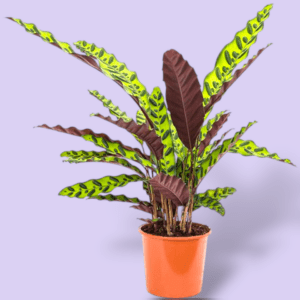 Indoor Plants, Live Plants & Neutrients, Plants for terrarium
Indoor Plants, Live Plants & Neutrients, Plants for terrariumCalathea Lancifolia Rattlesnake Plant
Size: 40cm
Calathea lancifolia, commonly known as the Rattlesnake Plant, is a fascinating and ornamental houseplant. Here’s a detailed description:
Appearance
- Foliage: The Rattlesnake Plant features slender, wavy-edged leaves that resemble a rattlesnake’s skin. The top side of each leaf has dark green ovals on a lighter green background, while the underside is a vibrant purple.
- Height: It typically grows to about 2 feet (60 cm) in height, making it an ideal size for indoor cultivation.
Growth Habit
- Clump-Forming: This plant has a clump-forming growth habit, creating a lush, full appearance with its foliage.
- Evergreen Perennial: Calathea lancifolia is an evergreen perennial, maintaining its vibrant foliage year-round.
Flowering
- Inconspicuous Flowers: While it can produce small, yellow flowers, it is primarily grown for its striking foliage. These blooms are rarely seen when the plant is kept indoors.
General Characteristics
- Native Habitat: This species is native to the Brazilian rainforests, where it thrives under the canopy in warm, moist, and shaded conditions.
- Non-Toxic: Calathea plants are non-toxic to cats, dogs, and humans, making them a safe choice for pet owners and families.
- Air Purifier: Beyond its ornamental appeal, it improves indoor air quality by filtering out pollutants.
Calathea lancifolia is a captivating addition to any indoor plant collection, thanks to its unique and decorative foliage.
SKU: n/a -
FANCY, LIVE FISH
Calico Ryukin Fancy Gold Fish
The Calico Ryukin goldfish is a popular and visually striking variety of goldfish, known for its unique coloration and distinctive body shape. Here’s a breakdown of its key features:.
1. Coloration (Calico):
– Calico refers to a multi-colored pattern that typically includes a mix of red, orange, black, white, and sometimes blue patches.
– The colors are often speckled or mottled, giving the fish a vibrant and eye-catching appearance.
– The black patches are a key characteristic of calico goldfish, distinguishing them from other color varieties.
2. Body Shape (Ryukin):
– The Ryukin goldfish has a deep, egg-shaped body with a pronounced hump on its back, just behind the head.
– It has a high dorsal fin, a long, flowing double tail (caudal fin), and paired pectoral and pelvic fins.
– The Ryukin’s body shape is more rounded compared to the sleeker Common or Comet goldfish
3. Size:
– Ryukin goldfish can grow to be 6-8 inches (15-20 cm) in length, though some may grow larger in optimal conditions.
– Their size depends on factors like tank size, diet, and overall care.
4. **Temperament**:
– Calico Ryukins are generally peaceful and social, making them suitable for community tanks with other fancy goldfish varieties.
– They are not fast swimmers due to their rounded body shape, so they should not be kept with more agile fish that might outcompete them for food.
### 5. **Care Requirements**:
– **Tank Size**: A minimum of 20 gallons for one Ryukin, with an additional 10 gallons for each additional fish.
– **Water Quality**: They require clean, well-filtered water with a temperature range of 65-75°F (18-24°C). Regular water changes are essential.
– Diet: A balanced diet of high-quality goldfish pellets, flakes, and occasional treats like bloodworms, brine shrimp, or blanched vegetables.
– Tank Setup: Provide plenty of open swimming space and avoid sharp decorations that could damage their delicate fins. Live or silk plants can be added for enrichment.
6. Lifespan:
– With proper care, Calico Ryukin goldfish can live for 10-15 years or even longer.
7. Breeding:
– Breeding Calico Ryukins requires a separate breeding tank and careful selection of healthy, mature fish.
– They are egg-layers, and the fry will need special care and feeding until they develop their colors and body shape.
The Calico Ryukin is a favorite among goldfish enthusiasts due to its stunning appearance and graceful swimming. If you’re considering keeping one, ensure you provide a suitable environment and proper care to keep it healthy and thriving!SKU: n/a -
Sold out!
-
Filter Media, Filters
CARBON AKTIV SMALL 300G
Size: 300 gA powerful filter material. It very efficiently removes residual medicines, chlorine, even odours and, above all, contaminants that result of organic waste. Carbon should not be used while the fish are under medical treatment. Inserting the filter material in Net Filter Bag is recommended for convenience.SKU: HO20600 -
LIVE FISH, SCHOOLING FISH
CARDINAL TETRA
Cardinal Tetras are small, colorful and peaceful fish that are popular among aquarium enthusiasts.
Here are some tips on how to take care of them:
Tank Size: Cardinal Tetras require a minimum of 10 gallons tank size, with a pH range of 5.0 to 7.0.
Water Parameters: They prefer soft and slightly acidic water with a temperature range of 72-82°F.
Tank Mates: Cardinal Tetras are peaceful fish and should be kept with other peaceful fish such as other tetras, rasboras, and small catfish.
Diet: They are omnivorous and require a balanced diet of high-quality flakes, pellets, and frozen foods such as bloodworms and brine shrimp.
Decorations: Provide them with plenty of hiding spots such as plants, driftwood, and rocks. They also prefer a dark substrate.Maintenance: Regular water changes of 25% every two weeks are recommended to maintain good water quality.
Breeding: Cardinal Tetras are difficult to breed in captivity. It is best to purchase them from a reputable breeder or retailer.
By following these tips, you can provide a healthy and comfortable home for your Cardinal Tetras.
NOTE: OUR LIVE FISHES ARE ONLY DELIVERED TO DUBAI AND SHARJAH.
CUSTOMERS FROM ABUDHABI AND OTHER EMIRATE MAY CONTACT US TO INQUIRE ABOUT THE DELIVERY.SKU: n/a -
-
Decoration
CERAMIC FISH BREEDING CONE
Size: Unit
Ceramic Fish Breeding Cone
- Ceramic spawning breed cone offers spawning web sites on your fish.
- Breeding cone for discus fish、angel fish and different substrate fish to spawn.
- Smooth floor for fish egg to attach on it easily, make certain excessive reproduction.
- The spawning breed cone made of ceramic fired from mineral soil, can process water filtration on your aquarium.
SKU: TW1004








